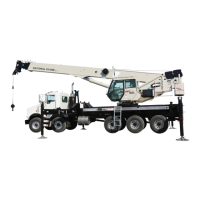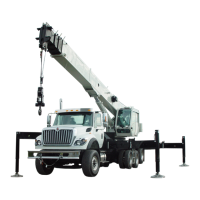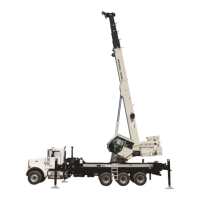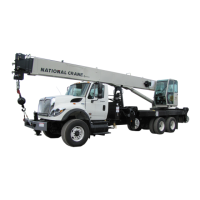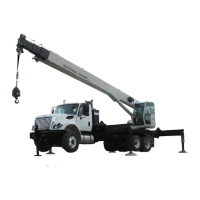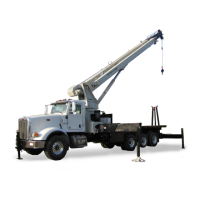NATIONAL CRANE Published 11-01-2020 Control # 710-00 2-17
NBT60XL OPERATOR MANUAL SAFETY PRECAUTIONS
Example and Sample Calculations (Non-metric)
The following example illustrates how to calculate allowable
load while operating in wind speed (3-second wind gust
speed) above 13.4 m/s (30 mph) and maximum permissible
wind speeds with various combinations of lifted load and
wind resistance area.
NOTE: Permissible and calculated wind speeds in this
example are the 3-second wind gust speeds at
boom tip height V(z).
Example 2:
Equipment is configured with:
• boom length = 90 ft,
• load radius = 40 ft, and
• wind speed is measured at V(z) ≤ 45 mph.
The Rated Load Chart Example - Non-metric (Figure 2-4),
at maximum permissible wind speed, V(z) = 30 mph, the
rated lifting capacity m
(allow)
for this configuration is
25,200 lb.
The maximum allowable wind resistance area of load is:
Awr
(allow)
= 0.0059 x m
(load)
(2.5)
Awr
(allow)
= 0.0059 x 25,200 = 149 ft
2
For the allowable wind speed > 30 mph and ≤ 45 mph,
reduce the allowable load. , the Factor for a main boom
length of 90 ft is 0.8, thus the allowable load is:
m
(allow)
= 0.8 x 25,200 = 20,160 lb
This reduced capacity load has an allowable wind resistance
area of:
Awr
(allow)
= 0.0059 x 20,160 = 119 ft
2
Example, wind speeds greater than 13.4 m/s is NOT
permissible to lift a load greater than 20,160 lb, even if the
wind resistance area of the load is less than 119 ft
2
.
Refer to the above equipment configuration for the following
load conditions:
Load example 2.1:
With known Wind Drag Coefficient of the load Cd,
• load to be lifted of 19,500 lb,
• Projected Wind Area Ap =70ft
2
,
• Wind Drag Coefficient Cd = 1.5
then the wind resistance area of load can be estimated as
Awr
(load)
= Ap x Cd = 70 x 1.5 = 105 ft
2
Refer to the above Lifting Limits at wind speed V(z) > 30
mph and ≤ 45 mph. Comparing the load and wind resistant
area to the allowable:
• Is the load to be lifted less than allowable load?
19,500 lb ≤ 20,160 lb YES
• Is Awr
(load)
less than Awr
(allow)
?
105 ft
2
≤ 119 ft
2
YES
Conclusion: This load is permissible to lift in wind speed up
to 45 mph.
Load example 2.2:
With unknown Wind Drag Coefficient of the load Cd,
• Load to be lifted of 18,000 lb,
• Projected Wind Area Ap = 45 ft
2
,
• Wind Drag Coefficient Cd = unknown
NOTE: If exact Wind Drag Coefficient is not known
, it shall
be assumed as 2.4.
the wind resistance area of load can be estimated as
Awr
(load)
= Ap x Cd = 45 x 2.4 = 108 ft
2
Refer to the above Lifting Limits at wind speed V(z)
>30mph and ≤ 45 mph. Comparing the load and wind
resistant area to the allowable:
• Is the load to be lifted less than allowable load?
18,000 lb ≤ 20,160 lb YES
• Is Awr
(load)
less than Awr
(allow)
?
108 ft
2
≤119ft
2
YES
Conclusion: This load is permissible to lift in wind speed up
to 45 mph.
Load example 2.3a:
With large wind resistance area of the load Awr
(load)
,
• Load to be lifted of 22,000 lb,
• Projected Wind Area Ap = 180 ft
2
,
• Wind Drag Coefficient Cd = 1.2
Lifting Limits at wind speed V(z) < 30 mph at this
configuration:
• Maximum load 25,200 lb
• Maximum wind resistance area of load 149 ft
2
Lifting Limits at wind speed V(z) > 30 mph
and ≤ 45 mph at this configuration:
• Maximum load 20,160 lb
• Maximum wind resistance area of load 119 ft
2
Fo
r
Reference
Only
